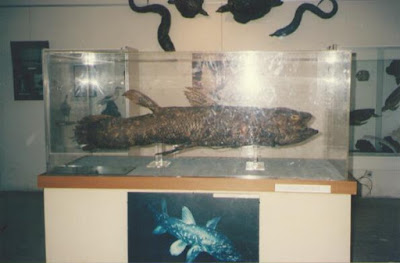To get to our diving holiday in Moheli we had to travel via Grande Comore (Ngazidja), which you can reach via a 2-hour direct flight from Reunion. We spent a night there before and after our Moheli flights as it is advisable to have leeway of at least 24 hours either side of your flight, owing to schedules changing at the last minute due to inclement weather or overbooking.
Our last trip to Grande Comore was in August 2000 (see below), and on our outbound trip we revisited the capital, Moroni, to see how much it had changed in eighteen years. I would have liked another look at the stuffed coelacanth at the Centre National de Documentation et de la Recherche Scientifiques, but unfortunately the museum was closed for renovation. I've been told the coelacanth is still there, just with a bit more dust.
 |
 |
| Photo of the coelacanth that I took in 2000 |
My other memory of Moroni was auditive, from the small harbour in front of the Old Friday Mosque: I remember hearing the sound of material being hammered into the spaces between the hull planks of the wooden dhows that were used to unload merchandise from larger ships offshore. However these dhows have now been replaced by more modern fibreglass boats and so the sound has disappeared.
| Old Friday mosque ("Badjanani Mosque") built in 1427 |
Not far away from the harbour is a sign proclaiming Mayotte est comorienne et le restera à jamais ("Mayotte is part of the Comoros and will always remain so"). This references the fact that the fourth island of the archipelago, Mayotte, is contested. It was the only island of the four that voted in referendums in 1974 and 1976 to retain its link with France and forgo independence (with 63.8% and 99.4% of votes respectively). A draft 1976 United Nations Security Council resolution recognizing Comorian sovereignty over Mayotte, supported by 11 of the 15 members of the Council, was vetoed by France. However since 1995 the subject of Mayotte has not been discussed by the General Assembly.
After Moheli on our trip back we had a car and driver meet us at the airport, and heading northwards our first stop was at the "Sceau de l'Islam aux Comores" a site dedicated to the first Comorian to make the pilgrimage to Mecca.
| wood carving above doorway, Sceau de l'Islam aux Comores |
On leaving the site we came across a number of men making galawa (pirogues), and we stopped to watch and ask some questions.
| making a galawa boat |
The next day, on our way to the airport, we saw some fishermen out in their galawa.
| out fishing in galawa, just north of Moroni |
Our next halt, appropriately enough, was at the site of the former Galawa Beach hotel, where we stayed in 2000 and which at the time was the islands' best hotel. This is an aerial view of what the hotel used to look like:
 |
| former Galawa Beach Hotel |
However despite being successful it was knocked down for political?/economical? reasons about ten years ago, and now there is virtually nothing left.
| looking over where the swimming pool used to be |
| beach at former Galawa Beach Hotel site |
Our next stop was the Lac Salé (Salty Lake) or Niamawi Lake to give it its proper name. This former volcanic crater is located in the far north of Grande Comore, and is reputed to be bottomless :-)
| salty Niamawi Lake |
We carried on down the island's east coast, stopping to look at the attractive Chomoni beach, before heading back to Moroni by cutting across the island on the RN4.
| Chomoni Beach |
Once again we were destined not to visit Mount Karthala, the island's highest point (2631m/7746 feet) and an active shield volcano - the most recent eruptions were in 2005 and 2006. On this occasion it was due to lack of time, in 2000 it was because of the lack of organised visits available (which may still be the case). Perhaps we'll get to climb it one day on another visit.
| Skipjack tuna for sale at Moroni harbour market |
Further reading:
- The Comoros: the islands the guidebooks forgot - by JamesStewart, 21st May 2017, The Times
Suggested book:
- Fish Caught In Time - the Search for The Coelacanth by Samantha Weinberg (2000)
Related blog posts:


